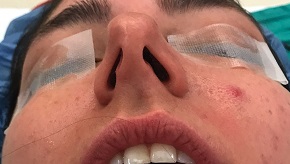Deviated Septum/Airway
 Septal deviation is when the cartilage inside the nose blocks the passage of air through the nostrils. This may be a result of trauma or from birth (congenital). The malformed septum can be removed or straightened to improve airflow.
Septal deviation is when the cartilage inside the nose blocks the passage of air through the nostrils. This may be a result of trauma or from birth (congenital). The malformed septum can be removed or straightened to improve airflow.
A deviated septum is a common cause of airway obstruction and breathing problems. Septal deviation is when the cartilage inside the nose blocks the passage of air through the nostrils. This may be a result of trauma or from birth (congenital). The malformed part of the septum can be removed or straightened to improve airflow. Typically, we leave around 10mm of L-shaped cartilage or more to provide support for the nose and prevent collapse.
Septoplasty, or altering of the septum, can be performed via either a closed (inside the nostril) or open approach (incision at the base of the nose similar to the incision used for rhinoplasty). More complicated septal deformities may require cartilage grafting to help re-shape and support the native septum.
The internal nasal valve is the junction between the septum and the upper lateral cartilages of the nose. When the angle between these two structures is narrow, difficulty in breathing occurs. The cottle test (pulling the cheek to the side) may demonstrate a narrow internal nasal valve if breathing is improved during this maneuver. Spreader grafts (cartilage placed between these two structures) may help improving breathing significantly as well prevent an inverted V-deformity.
The external nasal valve can be appreciated by looking at the base of the nose. When you breathe deeply, the alar cartilages collapse restricting airflow. Alar batten or lateral crural strut grafts can be used to help stent the nose open and prevent external valve collapse.
The turbinates are an organ inside our nose that is responsible for humidifying air. The mucosa surrounding the turbinate’s swells in response to allergy and turbulent airflow. This swelling reduces the size of the nasal passage and restricts airflow. Cauterizing and infracturing the inferior nasal turbinate can done to open the airway while preserving the ability to humidify air.